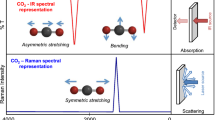Abstract
IT is well known that the flame of ammonia emits several characteristic bands. The appearance of the bands is strongly influenced by the temperature of the source. Thus the spectrum of the cool flame of ammonia is dominated by the diffuse so-called agroup in the yellow region. In the spectrum of a hot source of ammonia, burning in the electric are, the -group with its intensity maxima at 3370, 3360 is photographically by far the most intense. From investigations on the exciting conditions and on the structure of these bands, one may suppose that the very complicated -group is emitted by the excited NH3 or NH2 molecules, or a mixture of both, as one can distinguish with some degree of certainty two different systems in . Judging from some very distinct structural relations holding between the -group and the long series of known hydride spectra, we refer the origin of this group to the NH dipole. This will be discussed later. Other bands of the ammonia-oxygen flame are referred by Eder to NO compounds. Very recently, K. Gleu, in an interesting paper on the chemi-luminescence of chlorine trinitride in hydrogen trinitride (Zeits. f. Phys., 38, p. 176, 1926), reported some new bands of nitrogen hydride. From their symmetric positions around the -group and their comparatively simple structure we suggest that they also belong to the spectrum of the NH dipole.
Similar content being viewed by others
Author information
Authors and Affiliations
Rights and permissions
About this article
Cite this article
HULTHÉN, E., NAKAMURA, S. The Spectra of NH Compounds. Nature 119, 235–236 (1927). https://doi.org/10.1038/119235a0
Issue Date:
DOI: https://doi.org/10.1038/119235a0
- Springer Nature Limited





